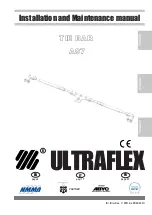
Operator's Manual
WP700Zi-OM-E-RevA
290
The hysteresis band divides the display into three zones. The ORM Package uses both the voltage threshold and
hysteresis settings to identify pits and spaces.
Criteria for identifying a “feature” (pit or space):
x
The first feature identified after the left parameter cursor can be either a pit or space. If the signal first
enters Zone 1, the first feature identified (if additional constants are met) will be a pit. If the signal first
enters Zone 3, it will be a space.
x
After first crossing into Zone 1 or Zone 3, the next time the signal crosses the voltage threshold, it is
recorded as the start time of a feature.
x
If the first feature to be identified is a pit (signal entered Zone 1 first), after crossing the voltage threshold
the signal must cross into Zone 3 and then pass the voltage threshold again to complete all conditions for
identification as a pit. The first time that the signal crosses the voltage threshold after entering Zone 3 is
recorded as the end time of the pit and the start time of the following space. The time between the start
and end of the pit is recorded as the pit width. If the first feature to be identified is a space, the signal first
entered Zone 3. The algorithm is used with directions reversed.
x
For the entire signal, only a space can be identified after a pit, and only a pit can be identified after a
space.
x
All subsequent features are identified by crossing into the appropriate zone after the end of the previous
feature. For a pit this is Zone 3, and for a space it is Zone 1. The end of the previous feature is the
beginning of the current feature being identified. The subsequent first time the signal crosses the voltage
threshold is recorded as the time of the feature being identified. At this point, the feature has been fully
identified.
nT Pit-Space Categorization
Because optical recording data is encoded using a pulse-width modulation mechanism, it is often useful to
perform signal analysis for selected pulse widths. Exploiting the fact that optical recording data widths are ideally
integral multiples of the data clock period ‘T’, the AORM Package separates optical recording signal pits and
spaces into groups whose widths fall into the same integral multiple of clock periods. As a result, ORMs can be
configured to provide values for only pits or spaces, or both of these for a selected ‘nT’ value (‘nT’ denotes an
integer multiple of the clock period) or for a range of ‘nT’s.
The ideal clock period (T) is configured on the parameter nT setup.
Categorization of pits and spaces by nT based on width is done using the following equation:
When this condition is met, the pit or space of width
w
is said to belong to the
n
th
index.
Summary of Contents for DDA 7 Zi series
Page 1: ...Operator s Manual WavePro SDA and DDA 7 Zi Series Oscilloscopes ...
Page 2: ... L R R H HUD RU D D ...
Page 41: ...Operator s Manual WP700Zi OM E RevA 40 The detachable WavePro Zi front panel ...
Page 376: ...WavePro 7Zi 375 WP700Zi OM E RevA Absolute Offset Relative ...
Page 439: ...Operator s Manual WP700Zi OM E RevA 438 ...
Page 440: ...WavePro 7Zi 439 WP700Zi OM E RevA ...
Page 544: ...Thank you for purchasing a WavePro SDA or DDA 7 Zi Oscilloscope ...















































